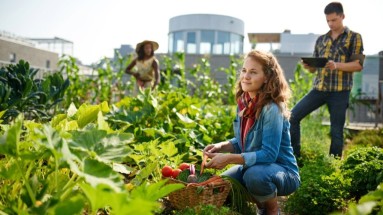Page content
Guest article Smart Gardening: How digital tools are changing gardening in rural areas

Bringing digitalization to the garden — smart gardening optimizes soil, irrigation, and planting. Photo: iStock
Gardening has long been considered an analog domain, shaped by intuition, experience, and a keen eye on the sky. But climate change and increasingly extreme weather conditions are changing the picture.
When heavy rain suddenly replaces drizzle or dry spells become more frequent, traditional routines quickly reach their limits. This is exactly where the digital transformation begins on a small scale: with sensors, apps, and platform solutions that make gardening more predictable, efficient, and sustainable. Smart gardening is more than just a technological gimmick—it combines a love of nature with digital precision.
Digital weather data: More accurate forecasts for smarter planting decisions
Whether sowing, fertilizing, or pest prevention—in the garden, a lot depends on the right timing. And that, in turn, depends on the weather. But traditional weather forecasts on TV or radio often provide only rough guidelines. Local differences are particularly significant in rural areas, where microclimates and terrain play a decisive role. Digital weather services are therefore increasingly relying on hyperlocal models that use AI, satellite data, and ground-level sensors to provide forecasts at the zip code level—sometimes even with hourly resolution.
Applications that not only display the weather but also interpret it are particularly helpful in practice. Today, smart gardening apps not only tell you that it's going to rain, they also calculate how much water will actually reach the ground, how evaporation will develop, and whether additional watering is necessary. Combined with soil sensors and historical weather data, hobby gardeners and small direct marketers can make informed decisions, such as choosing the right varieties for their location or the optimal planting time.
“Experts agree that the right use of digital technology in agriculture would give us the greatest leverage for sustainability.” - Franziska Kersten, Member of the German Bundestag and veterinarian
This empirical knowledge is now being supplemented by digital precision. The integration of such services into existing agricultural platforms or open-source systems makes it possible to link weather data with other factors, such as harvest calendars or pest warning systems. This is giving rise to the first small-scale digital ecosystems in which even non-professional users can act on the basis of data. The garden thus becomes a networked observation laboratory that helps to better understand climate change and respond to it locally.
Irrigation reimagined: automation for climate-adapted gardens
Efficient water use is increasingly becoming a key issue in gardening—not only in urban climate zones, but also in rural areas. Digital irrigation systems offer a solution that can bridge the gap between resource conservation and plant needs. Sensor-based controls measure soil moisture, air temperature, and evaporation rates to adjust watering precisely to the current situation. This not only reduces the burden on users, but also helps to conserve groundwater and infrastructure.
In practice, many of these systems can be operated via an app – from classic timers to AI-supported systems that incorporate weather forecasts and plant data. Such solutions open up new perspectives, especially in areas with an uncertain water supply or poor social infrastructure: the maintenance of kitchen gardens becomes more predictable and yields more stable. In addition, automated systems also enable older or mobility-impaired people to cultivate their gardens independently – a social aspect of the digital transformation in the green sector that should not be underestimated.
Soil, sensor technology & data analysis: From the garden bed to the digital testing ground
The soil is the foundation of any successful gardening – but for a long time, its condition remained something of a “black box.” Digital sensor technology is changing that fundamentally. There are now systems that not only measure moisture, but also pH, nutrient availability, and soil temperature. Combined with weather and location data, this provides a detailed picture of the conditions in the garden bed – virtually in real time. This enables precise decisions to be made: Does the soil need more fertilizer? Is the substrate acidic? Or is there enough heat for a sensitive vegetable variety?
Another advantage is that many systems store data long-term and make it available in a visually appealing format. This allows patterns and correlations to be identified, such as how soil life changes over the season or which interventions have led to which results. For ambitious hobby gardeners and small agricultural initiatives alike, this is creating a new way of gardening – data-driven, transparent, and traceable. And as an added bonus, this approach also promotes an understanding of local ecological relationships.
Platform solutions & smart helpers: connected knowledge for smart regions
Digital solutions often only reveal their full potential when they are connected with each other. This is exactly where modern gardening platforms and modular app ecosystems come in. They combine various digital tools – such as weather data, soil analyses, and planting calendars – in a single interface. This provides a comprehensive overview of the condition of the garden and the tasks at hand. Recommendations for variety selection or cultivation planning can also be derived in a context-sensitive manner, for example, adapted to the current precipitation situation or local soil conditions.
Another exciting trend is the opening up of such platforms for the sharing of knowledge. Community functions, regional networks, and open data pools allow people to share experiences and learn from each other—even beyond village boundaries. This offers enormous potential for smart regions: gardens are not only digitally controlled, but also become places of networked learning. In this way, digital literacy in rural areas grows with every garden bed – in a low-threshold, practical way that is in harmony with nature.
Small projects with a big impact – and why gardens deserve digital attention
The digitization of rural areas does not begin with broadband expansion or digital citizen services – it can also take root in the garden fence. Smart gardening shows how technical innovations can have a concrete impact even in small, everyday areas: weather apps help with planning, sensors provide reliable soil information, and automated systems ensure yields even in increasingly uncertain weather conditions. All of this often happens invisibly – and that is precisely where its particular strength lies. These digital helpers integrate seamlessly into everyday life, lower barriers to entry, and promote an understanding of data and contexts that extends far beyond the garden bed. When gardens become digital learning spaces and testing grounds for dealing with resources, climate change, and technology, they make a valuable contribution to regional development—quietly, locally, and with a surprisingly large impact.
Written by: Eng. Matthias Jünger, MBA

Matthias Jünger runs the platform Garden-Shop.at and lives his passion for gardening with every handful of soil. His goal: to make gardening accessible and meaningful for everyone – with a special focus on sustainable gardening, permaculture, and climate-resilient gardening.
Save your free ticket now!
Join us for three days of key highlights on the digital transformation of public administration, Smart Cities, and Smart Regions – featuring exciting keynotes, inspiring panels and plenty of networking opportunities. Discover how to successfully navigate the opportunities and challenges of digitalization.



